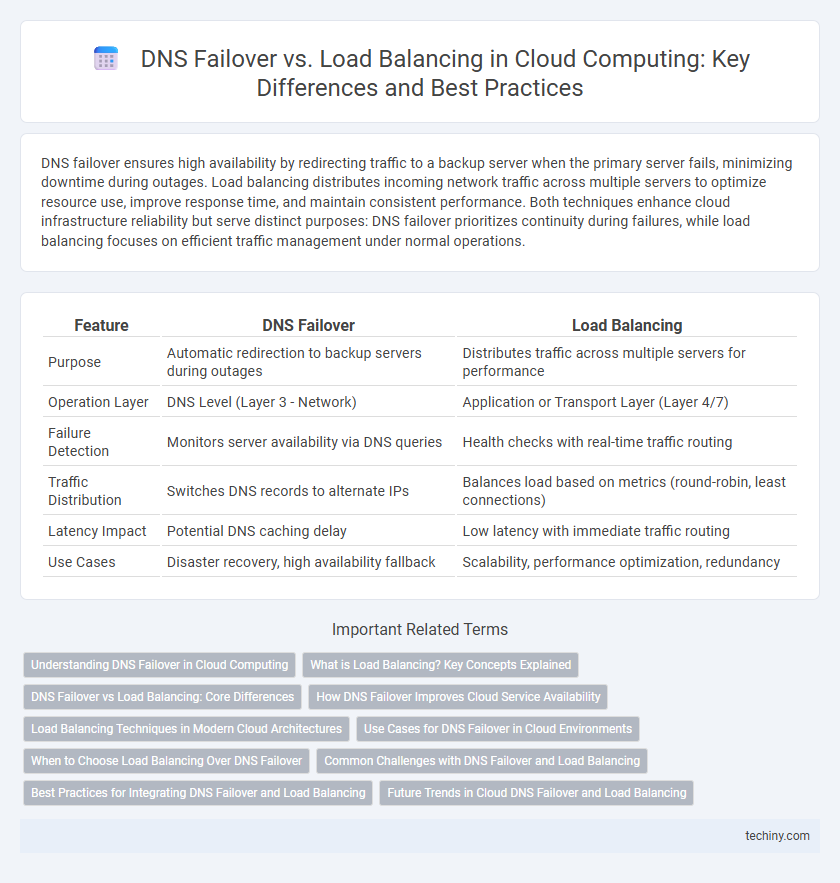DNS failover ensures high availability by redirecting traffic to a backup server when the primary server fails, minimizing downtime during outages. Load balancing distributes incoming network traffic across multiple servers to optimize resource use, improve response time, and maintain consistent performance. Both techniques enhance cloud infrastructure reliability but serve distinct purposes: DNS failover prioritizes continuity during failures, while load balancing focuses on efficient traffic management under normal operations.
Table of Comparison
| Feature | DNS Failover | Load Balancing |
|---|---|---|
| Purpose | Automatic redirection to backup servers during outages | Distributes traffic across multiple servers for performance |
| Operation Layer | DNS Level (Layer 3 - Network) | Application or Transport Layer (Layer 4/7) |
| Failure Detection | Monitors server availability via DNS queries | Health checks with real-time traffic routing |
| Traffic Distribution | Switches DNS records to alternate IPs | Balances load based on metrics (round-robin, least connections) |
| Latency Impact | Potential DNS caching delay | Low latency with immediate traffic routing |
| Use Cases | Disaster recovery, high availability fallback | Scalability, performance optimization, redundancy |
Understanding DNS Failover in Cloud Computing
DNS failover in cloud computing ensures high availability by automatically redirecting traffic to a backup server when the primary server becomes unreachable. It relies on health checks that monitor server status and update DNS records dynamically to maintain uninterrupted service. This approach minimizes downtime and enhances resilience by quickly adapting to server failures within distributed cloud environments.
What is Load Balancing? Key Concepts Explained
Load balancing distributes incoming network traffic across multiple servers to ensure reliability, optimize resource use, and prevent any single server from becoming a bottleneck. Key concepts include algorithms like round-robin, least connections, and IP hash, which determine how traffic is allocated for efficient processing. Load balancing improves application availability, scalability, and performance by dynamically directing user requests to the healthiest and fastest servers within a cluster.
DNS Failover vs Load Balancing: Core Differences
DNS failover automatically redirects traffic to a backup server when the primary server becomes unavailable, ensuring high availability by minimizing downtime. Load balancing distributes incoming network traffic across multiple servers to optimize resource use, maximize throughput, and reduce response time. While DNS failover reacts to outages by switching traffic between servers, load balancing proactively manages traffic distribution to enhance performance and scalability.
How DNS Failover Improves Cloud Service Availability
DNS failover enhances cloud service availability by instantly redirecting traffic to backup servers when primary servers become unreachable, minimizing downtime and ensuring continuous access. This mechanism monitors server health and triggers DNS record updates in real-time, maintaining seamless user experience even during failures. Unlike traditional load balancing, DNS failover provides a cost-effective redundancy solution by leveraging DNS to maintain service uptime across distributed cloud environments.
Load Balancing Techniques in Modern Cloud Architectures
Load balancing techniques in modern cloud architectures distribute incoming network traffic across multiple servers to enhance application availability, scalability, and performance. Common methods include round-robin, least connections, and IP hash algorithms, each optimizing resource utilization and user experience in different scenarios. Advanced cloud platforms integrate load balancing with health checks and auto-scaling to dynamically adjust traffic flow based on server status and demand fluctuations.
Use Cases for DNS Failover in Cloud Environments
DNS failover in cloud environments ensures high availability by redirecting traffic to backup servers during primary site outages, minimizing downtime for mission-critical applications. It is essential for disaster recovery scenarios where instant rerouting prevents service disruption caused by hardware failures, DDoS attacks, or network issues. Cloud providers often integrate DNS failover with health checks to automate failover processes, enhancing resilience for distributed applications and multi-region deployments.
When to Choose Load Balancing Over DNS Failover
Load balancing is ideal when distributing incoming network traffic across multiple servers to optimize resource use, minimize response time, and prevent server overload. In scenarios requiring real-time traffic management and seamless session persistence, load balancers provide more granular control compared to DNS failover. Choose load balancing over DNS failover for applications demanding high availability, low latency, and dynamic scaling in multi-server environments.
Common Challenges with DNS Failover and Load Balancing
DNS failover often struggles with propagation delays that hinder rapid recovery during outages, causing intermittent downtime. Load balancing faces challenges with uneven traffic distribution and session persistence, which can impact application performance and user experience. Both methods require careful configuration and monitoring to prevent single points of failure and ensure high availability in cloud computing environments.
Best Practices for Integrating DNS Failover and Load Balancing
Implementing DNS failover alongside load balancing enhances application availability and performance by automatically redirecting traffic during server failures while distributing load during normal operation. Best practices include configuring health checks for failover triggers, using weighted load balancing to prioritize resources, and ensuring DNS TTL settings balance responsiveness with caching efficiency. Combining DNS failover with load balancing policies ensures seamless traffic management and minimizes downtime in cloud environments.
Future Trends in Cloud DNS Failover and Load Balancing
Future trends in cloud DNS failover and load balancing emphasize increased automation driven by artificial intelligence and machine learning to predict and mitigate service disruptions proactively. Edge computing integration enhances latency reduction and resilience by distributing traffic management closer to end-users, optimizing performance in hybrid and multi-cloud environments. Enhanced security protocols, including zero-trust architectures and advanced encryption methods, are becoming integral to protect DNS infrastructure against evolving cyber threats.
DNS Failover vs Load Balancing Infographic

 techiny.com
techiny.com